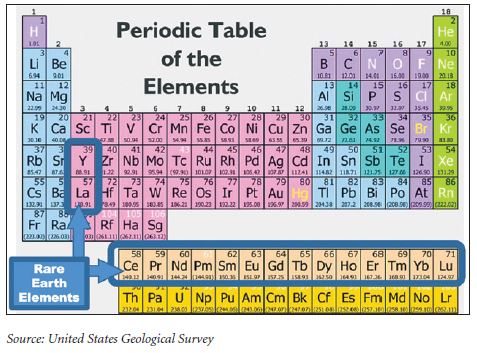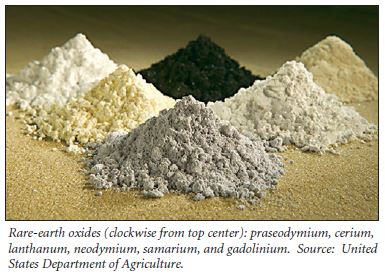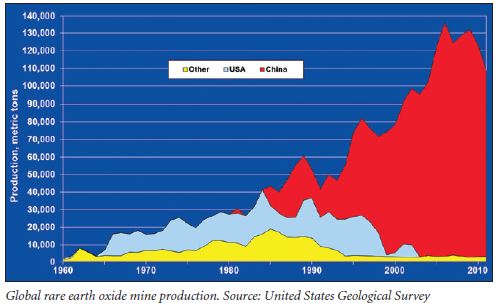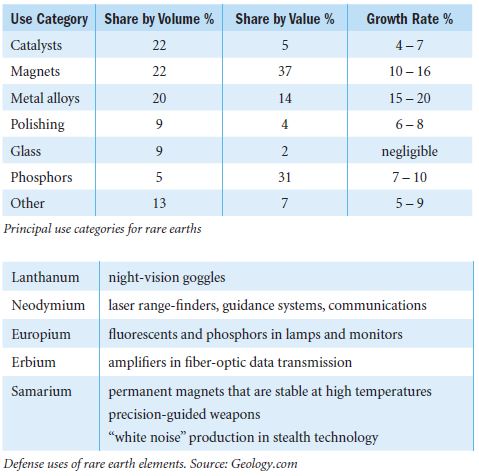|
Samarium, Praseodymium, Terbium, Lutetium. These sound odd. Are these break-away republics from the old Soviet Union? Maybe some new wonder drugs for weigh loss or baldness? In fact, these are members of a group of chemicals known as rare earth elements.
The availability and supply of rare earth elements have become critical in the functioning of our modern high-tech economy. Concerned strategists may say the United States faces a crisis in the reliability of this supply due to a lack of domestic production and that the control of the majority of the world’s supply of rare earth elements by China puts the United States at risk of a supply disruption.
So, what are rare earth elements? How is their occurrence and abundance influenced by geology? And, why are they important?
Rare Earth Elements
Rare earth elements (REEs) are a group of seventeen metallic elements that occur together in the periodic table. The group consists of yttrium and the 15 lanthanide elements (lanthanum, cerium, praseodymium, neodymium, promethium, samarium, europium, gadolinium, terbium, dysprosium, holmium, erbium, thulium, ytterbium, and lutetium). Scandium is found in most REE deposits and is sometimes classified as a REE. The International Union of Pure and Applied Chemistry includes scandium in their definition of REEs.
These metals have many similar geochemical properties that often cause them to be found together in geological deposits. These metals are silver, silvery-white, or gray with a high luster and high electrical conductivity. Because these metals all bond strongly to oxygen, they tend to occur together in the structure of various minerals. These bonds also make them hard for refiners to separate.
The REEs are not as rare as their moniker would suggest. According to the United States Geological Survey (USGS) Scientific Investigations Report 2010-5220, titled the “Principal Rare Earth Element Deposits of the United States”, by the authors K. R. Long, B. S. Van Gosen, N. K. Foley, and D. Cordier, the estimated average concentration of the REEs in the Earth’s crust ranges from around 150 to 220 parts per million. These concentrations exceed that of many other metals that are industrially mined such as copper (55 parts per million) and zinc (70 parts per million). Unlike most commercially-mined base and precious metals, however, REEs are rarely concentrated into mineable ore.
 The Geology of Rare Earth Elements The Geology of Rare Earth Elements
Economically important occurrences of REEs are associated with several varieties of uncommon alkaline igneous rocks including carbonatite, alkaline intrusive complexes, and peralkaline formations, as well as their weathering products. The United States has recently conducted studies of the occurrence and distribution of REEs. The USGS’s Mineral Resources Program’s Open-File Report 2011–1256, “Carbonatite and Alkaline Intrusion-Related Rare Earth Element Deposits – A Deposit Model” by Philip L. Verplanck and Bradley S. Van Gosen, presents the findings of some of this recent work.
As described in the USGS report, alkaline rocks form an expansive category of igneous rocks. Using a broad definition, alkaline rocks are deficient in SiO2 relative to Na2O, K2O, and CaO. Carbonatites are defined by the International Union of Geological Sciences (IUGS) system of igneous rock classification as having more than 50% primary carbonate minerals, such as calcite, dolomite, and ankerite, and less than 20% SiO2. Most identified carbonatites are intrusive bodies, but a few extrusive examples are known, most prominently an active carbonatite volcano in northern Tanzania. Peralkaline rocks are one subset of alkaline rocks, defined by (Na2O + K2O)/(Al2O3)>1.
Mineral deposits associated with carbonatites account for the greatest production of REEs. Important deposits are the Bayan Obo deposit in Inner Mongolia in China, and the Sulphide Queen carbonatite of the Mountain Pass district, California. Until the late 1980s, the Mountain Pass mine was the largest global producer of REEs, subsequently supplanted by the Bayan Obo deposit, which is currently the largest producer of REEs. Carbonatite REE deposits are extremely enriched in light REEs, particularly lanthanum, cerium, and neodymium. Although there are no peralkaline alkaline intrusion-related deposits currently being mined for REEs, many are in various stages of exploration because these igneous rocks contain relatively high concentrations of heavy REEs.
Carbonatites and peralkaline igneous rocks tend to occur within stable continental tectonic units, in areas defined as shields, cratons, and crystalline blocks; they are generally associated with intracontinental rift and fault systems. These igneous rocks formed from the cooling of silica-undersaturated, alkaline magmas, which were derived from repeated partial melting in the Earth’s upper mantle. The evolution of these initial mantle melts is not well understood. When these magmas ascend through the Earth’s crust, their chemical composition undergoes changes in response to variations in pressure, temperature, and composition of surrounding rocks. The result is an astonishing diversity of rock types that are variably enriched in economic elements such as zirconium, niobium, strontium, barium, lithium, and the REEs.
The principal REE-bearing minerals associated with carbonatites are fluocarbonates (bastnäsite, parasite, and synchysite), hydrated carbonates (ancylite), and phosphates (monazite and apatite). Other REE phases are less common, such as britholite and burbankite.
 A common feature of most carbonatite and alkaline intrusion-related deposits is that the surrounding rocks have been hydrothermally altered because of alkali metasomatism. This style of alteration is known as fenitization, so-named because it was first described at the Fen alkaline complex in southern Norway. Alkali-rich fluids are released into the country rock from the crystallizing magma, and reactions convert the host rock minerals to an assemblage of alkali-bearing minerals. Fenites can be classified as sodium or potassium rich. Sodium-rich fenites are characterized by the presence of alkaline feldspar with alkali amphibole or sodic pyroxene, and potassium-rich fenites contain potassium feldspar. A common feature of most carbonatite and alkaline intrusion-related deposits is that the surrounding rocks have been hydrothermally altered because of alkali metasomatism. This style of alteration is known as fenitization, so-named because it was first described at the Fen alkaline complex in southern Norway. Alkali-rich fluids are released into the country rock from the crystallizing magma, and reactions convert the host rock minerals to an assemblage of alkali-bearing minerals. Fenites can be classified as sodium or potassium rich. Sodium-rich fenites are characterized by the presence of alkaline feldspar with alkali amphibole or sodic pyroxene, and potassium-rich fenites contain potassium feldspar.
Potentially useful concentrations of REEs can also be found in pegmatites and placer deposits. Among pegmatites, very coarse grained intrusive igneous rocks, the niobium-yttrium-fluorine family comprises a large number of subtypes formed in different geologic environments. These subtypes are granitic in composition and are usually found peripheral to large granitic intrusions. REE-bearing pegmatites have a limited extent and are of economic interest only to mineral collectors.
Placer deposits are sedimentary accumulations of the REE-bearing minerals, typically monazite and xenotime. Heavy minerals weathered from deeply eroded host rocks are preferentially sorted by hydraulic processes in fluvial or marine environments due to their higher densities. The source rock need not be an alkaline igneous rock. Many common igneous, metamorphic, and even older sedimentary rocks contain enough monazite to make the mineral ubiquitous in placer deposits. Placers types with the greatest concentrations of monazite are typically ilmenite-heavy mineral placers, which have been mined for titanium oxide pigments, and cassiterite placers, which are mined for tin.
Rare Earths in Texas
REEs have been extracted from at least three locations in Texas. These include the Williams mine in Llano County, the Cornudas Mountains in Hudspeth County, and the Caballo Mountains in Fisher County. Several tons of pegmatite ore were extracted from the Williams mine for the minerals prior to 1909. According to P. Möller in the 1989 paper, “Rare Earth Mineral Deposits and their Industrial Importance,” the REE-bearing minerals allanite, gadolinite, and fergusonite were mined along with fluorite from the Middle Proterozoic Town Mountain Granite.
In Hudspeth County, the REE-bearing minerals eudidymite and bastnäsite were extracted from the Victorio Peak Formation on the Diablo Plateau. A 1987 report, Alkaline Rocks and Carbonatites of the World, Part 1, by A.R. Woolley, published by the British Museum of Natural History, indicates that the ore was mined from the nepheline, syenite, and phonolite alkalic igneous host rocks. In the Caballo Mountains, Woolley reports that bastnäsite was mined from quartz monzonite and potassic dikes.
 Expensive Extraction Expensive Extraction
The extraction of the metallic REEs from ores is difficult and costly. The ores are mineralogically and chemically complex and commonly radioactive. The already difficult metallurgical processes are compounded by the unique composition of each ore. No two are truly alike and there is no standard process for extracting and refining the ore into marketable materials. Before a new mine can be brought on line, extensive and costly testing is required using a variety of known and experimental extraction methods to optimize processing.
When elements of interest are found in two or more mineral phases within the same host material, each requiring a different extraction technology, the mineral processing is technically challenging. Current mineral-processing practices are capable of sequential separation of multiple mineral phases from one ore, but these methods are often not cost effective. Consequently, deposits where only one REE is concentrated will have a competitive cost advantage over deposits where multi-element extraction is conducted. To date, production has largely come from single-mineral-phase deposits, such as Bayan Obo (bastnäsite) in China, Mountain Pass (bastnäsite) in California, and heavy-mineral placers (monazite).
REE-bearing minerals, once separated, contain as many as 14 individual REEs that must be further separated and refined. The principal deleterious impurity is radioactive thorium. Because radioactive materials are difficult to mine and handle safely, they are heavily regulated. Radioactive mining tailings are often classified as hazardous waste requiring special and expensive disposal methods. The cost of handling and disposing of radioactive material is a serious impediment to the economic extraction of the more highly-radioactive REE-rich minerals. Monazite in particular typically contains considerable amounts of thorium.
Demand and Production
Before 1950, there was relatively little demand for REEs. At that time, most of the world’s supply was produced from placer deposits in India and Brazil and the Mountain Pass Mine in California was producing minor amounts of rare earth oxides from a Precambrian carbonatite. The demand for REEs began to accelerate in the mid-1960s as color televisions were beginning to be manufactured for the mass market. Europium was the essential material for producing the phosphors for the color images. Bastnäsite from the Mountain Pass Mine contained about 0.1% europium. By 1970, this demand made the Mountain Pass Mine the largest REE producer in the world and the United States the leading producer.
China began producing rare earth oxides in the early 1980s and became the world’s leading producer and exporter by the early 1990s. Through the 1990s and early 2000s, China steadily strengthened its share of the world’s rare earth oxide market. The Mountain Pass Mine, and many others throughout the world, were unable to compete with the low cost of production in China and stopped operation.
At the same time, world demand for rare earth metals was burgeoning with their use in materials for a wide variety of defense, aviation, industrial, and consumer electronics products. China capitalized on its dominant position, more than 90% of world production, by restricting exports in 2010 and allowing rare earth oxide prices to rise to historic levels. Due to these rising prices, mining companies in the United States, Australia, Canada and other countries began to reevaluate old REE prospects and explore for new ones. In 2012, the Mountain Pass Mine came back into production and the United States produced about 6% of the world’s REEs, with Australia making a little over 3%. Additionally, exploration and development projects have been initiated in Brazil, Finland, Greenland, India, Kyrgyzstan, Madagascar, Malawi, Mozambique, South Africa, Sweden, Tanzania, Turkey, and Vietnam.
Since 2010, prices have dropped sharply as the global economy slowed, new sources have come online, and companies developed methods to use less. Lanthanum oxide is currently around $6 per kilogram, far below its price of $104 in 2011, according to data provided by Australian rare-earth producer Lynas Corp and Mineralprices.com.
Uses
Although industrial demand for REEs is relatively small in tonnage terms, the materials are essential for a diverse and expanding array of industrial and high-technology applications. The primary uses are for chemical catalysts, metallurgy, and glass polishing. Increasing amounts of REEs are used in magnets, metal alloys for batteries and lightweight structures, and phosphors essential for many current and emerging alternative energy technologies, such as electric vehicles, energy-efficient lighting, and wind power. Several pounds of rare earth compounds are in batteries that power every electric and hybrid-electric vehicle. REEs also play an essential role in our national defense in their use in night-vision goggles, precision-guided weapons, communications equipment, GPS equipment, batteries and other defense electronics.
 Strategic Implications Strategic Implications
The global production and supply of REEs comes from only a few sources, with China foremost among them. The USGS Open-File Report 2011-1042, “China’s Rare-Earth Industry”, 2011, by P. Tse, points out that because of China’s earlier decisions to restrict exports, the United States and other developed nations have heightened concerns about future availability. In a December 13, 2013, Wall Street Journal article titled, “China Seeking to Trim Exports of Rare-Earth Minerals”, author Chuin-Wei Yap reported that China implemented a second round of export quota reductions of REEs despite a shrinking share of the global output. China’s Commerce Ministry said it would set its rare-earth export quotas for 2014 at 15,110 metric tons, a 2.5% decline from last year.
China’s announcement of lowered export quotas for REEs for 2014 was made despite a ruling against such export quotas by the World Trade Organization. Several recent legislative actions in the United States are aimed at mitigating the possible threat of REE supply disruptions. The National Defense Authorization Act authorizes the Pentagon to stockpile certain critical minerals, including dysprosium and yttrium. Using the National Defense Stockpile Transaction Fund, the Department of Defense may spend up to $41 million to acquire specified materials for each fiscal year from 2014 to 2019. In addition, the Defense Logistics Agency will encourage the domestic supply of strategic and critical minerals.
According to the Congressional Research Report, “Rare Earth Elements in National Defense” released in December 2013, United States policymakers have expressed growing concern that the nation has lost its domestic capacity to produce strategic and critical materials. The Critical Minerals Policy Act of 2013 included directives to develop methods for determining which minerals are critical resources, based on supply restrictions and demand, and to establish a comprehensive national assessment of critical minerals.
Meanwhile, a January 2014 article by Per Liljas in Time Magazine says that the British Islands-based private equity firm SRE Minerals Limited has announced that a geological study identified a deposit containing 216 million tons of REEs in North Korea. If verified, the discovery would more than double global known resources and be six times greater than the reserves in China. The report indicates that SRE Minerals Limited entered into a 25-year deal to develop the deposits in Jongju, northwest of the capital, Pyongyang. The USGS said there was insufficient information to comment on the significance of the announcement. SRE acknowledges the estimates are conceptual and not yet proven.
Summary
Maybe the REEs are not so much rare as undervalued. The geology and occurrence of the REEs is complex and the extraction technically challenging. When the invisible hand market finds the right price, multiple sources become available. So, it is not geology or engineering that makes REEs precious, but economics: supply and demand.
|


 The Geology of Rare Earth Elements
The Geology of Rare Earth Elements A common feature of most carbonatite and alkaline intrusion-related deposits is that the surrounding rocks have been hydrothermally altered because of alkali metasomatism. This style of alteration is known as fenitization, so-named because it was first described at the Fen alkaline complex in southern Norway. Alkali-rich fluids are released into the country rock from the crystallizing magma, and reactions convert the host rock minerals to an assemblage of alkali-bearing minerals. Fenites can be classified as sodium or potassium rich. Sodium-rich fenites are characterized by the presence of alkaline feldspar with alkali amphibole or sodic pyroxene, and potassium-rich fenites contain potassium feldspar.
A common feature of most carbonatite and alkaline intrusion-related deposits is that the surrounding rocks have been hydrothermally altered because of alkali metasomatism. This style of alteration is known as fenitization, so-named because it was first described at the Fen alkaline complex in southern Norway. Alkali-rich fluids are released into the country rock from the crystallizing magma, and reactions convert the host rock minerals to an assemblage of alkali-bearing minerals. Fenites can be classified as sodium or potassium rich. Sodium-rich fenites are characterized by the presence of alkaline feldspar with alkali amphibole or sodic pyroxene, and potassium-rich fenites contain potassium feldspar. Expensive Extraction
Expensive Extraction Strategic Implications
Strategic Implications